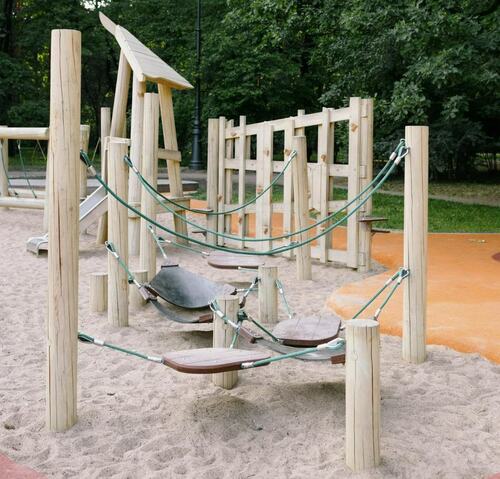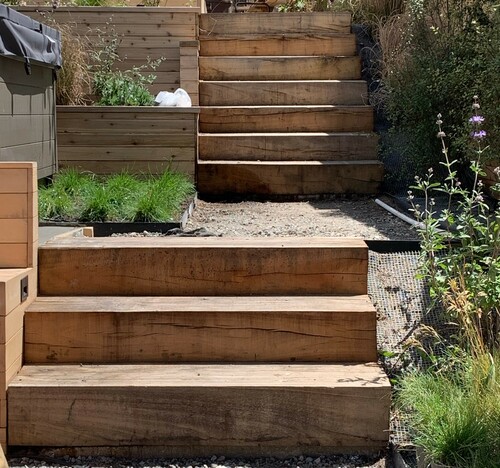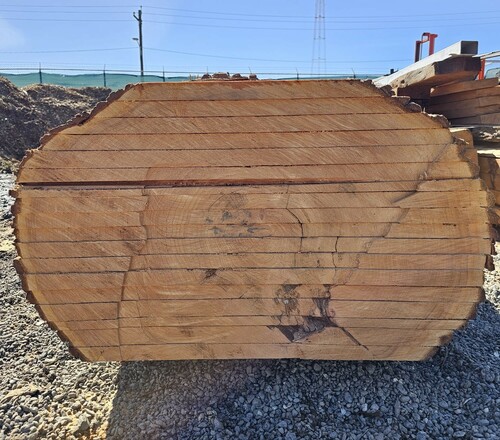Understanding Treated Lumber: What You Need to Know
What is Treated Lumber/Wood?
Treated lumber has undergone a chemical process that makes the wood more resistant to rot, decay, and insect damage. This chemical processing extends the lifespan of the wood, especially when used for outdoor projects. The chemicals also pose serious health and environmental concerns, however.
Is Treated Lumber the Same as Pressure-Treated Wood?

Stacks of Treated Wooden Planks – Photo by Óscar Salgado on Unsplash
Treated wood is regularly referred to as “pressure-treated wood” because of the chemical infusion process through which chemicals are pushed into the wood itself. The wood is placed in a pressurized chamber that’s filled with the chemicals, and the pressure forces chemicals deep into the wood fibers.
Treated lumber is becoming the more common term because it’s the chemical treatment that ultimately preserves the wood. The pressure is simply the means by which chemicals are infused.
What Chemicals Are Used in the Chemical Treatment of Wood?
Treated lumber can have several different chemicals that likely (or definitely do) cause harm. Some of the most common chemicals used in treated lumber are:
- Chromated Copper Arsenate (CCA) : CCA contains arsenic, which is a known carcinogen. CCA was voluntarily phased out of residential construction in 2003 but continues to be used in nonresidential applications. Homeowners should be aware of this if using reclaimed wood.
- Creosote : Creosote is classified as a probable human carcinogen, with exposure potentially leading to respiratory issues. It’s a tar-based preservative, and it is still widely used on railroad ties and utility poles.
- Pentachlorophenol : Pentachlorophenol poses a particular risk to aquatic life but can have harmful effects on humans and nonaquatic animals too. This is a known carcinogen, but it is still used in railroad ties and utility poles.
- Borate : Borate is a salt that’s sometimes used in treated wood, but it still poses a concern and has limited use. Long-term exposure can eventually lead to reproductive issues . Because it’s salt, borate-treated wood is only suited for indoor applications, as any water exposure would slowly dissolve the salt from the wood. The primary use is right where it’d be most exposed to individuals.
Each of these chemicals poses threats, proven or probable, to people and the environment.
What Health and Environmental Risks Does Treated Lumber Pose?
Research from the National Institute of Health (NIH) and other organizations has shown multiple health and environmental risks. The chemical treatment of wood can cause:
- Cancer
- Respiratory issues
- Reduced fertility
- Environmental contamination
Where is Treated Lumber Used?

Playground Equipment Likely Built with Treated Wood – Photo by Ksenia Chernaya
Treated lumber has a wide range of commercial applications in outdoor residential, commercial, industrial, marine, and infrastructure construction. All of these use cases pose real health and environmental concerns.
Residential use of treated wood puts these chemicals right where families live. This can pose multiple health concerns:
- Remodeling: When remodeling, fixing, or disassembling an outdoor structure, the sawdust from treated lumber can enter a home. This is a particular concern if it gets into the HVAC system, and is dispersed throughout the house.
- Young Children: Babies and toddlers are known to gnaw on wood and can directly ingest the harsh chemicals if they chew on treated wood. Porch railings, outdoor furniture, and swing sets are particular concerns.
- Leaching: The chemicals can eventually leach or seep out of the wood into a home’s yard. While this poses obvious local environmental concerns, it’s a direct threat to families if they garden or have a dog who digs.
- Future Owners: Because chemicals can remain in the ground for years or decades, leached chemicals can impact not only the current owner or tenant but also future ones. If a pressure-treated deck or swing set is taken down, future owners might not even know that chemicals could be in the ground.
Pressure-treated lumber is not the same as lead paint. Lead paint shows just how severe and long-lasting the effects of using harmful building materials can be, though.
The other uses in commercial, industrial, marine, and infrastructure construction can likewise have serious negative effects. While these might not be as immediately threatening to families, they come with long-term risks on a much larger scale. The following are just a few specific examples:
- Schools and Playgrounds: Using treated lumber anywhere in schools or playgrounds poses some of the same risks that using treated lumber in homes does. Any time chemicals are placed where children spend time and play, those chemicals could get into children’s bodies.
- Railroad Ties: Railroad ties have long been treated with some of the harshest chemicals used in pressure-treated wood. Any leaching could extend in a strip for miles and miles. The same is largely true for utility poles, which are also highly treated.
- Marine: Treated wood used in docks, boathouses, and other marine construction can leach into waterways, especially since the wood is usually exposed to (if not sitting in) water year-round. Once chemicals leach into a body of water, they can have local and far-reaching negative effects.
In addition to these risks, using any reclaimed wood that’s treated lumber can pose additional risks for individuals and families. DIYers and woodworkers should educate themselves on the risks of using reclaimed railroad ties, pallet wood, or other treated reclaimed lumber.
Are There Natural Wood Alternatives to Treated Lumber?

Untreated Lumber Custom-Milled by Arborist Now
Yes, there are several natural wood alternatives to treated lumber. This is especially true in residential construction, but there are also safer options for many nonresidential projects.
Certain natural wood solutions are still highly durable, even in outdoor settings, while also being safer and environmentally friendly. They don’t cause cancer, respiratory problems, reproductivity issues, or harm to the local environment. This is wood as nature intends it.
These natural woods are also often referred to as “green timber.” They’re “green” in the sense that chemicals and heat haven’t been used to treat them. Green timber is freshly cut and easy to use.
Alternative woods are even preferable to other sustainable wood alternatives, as they’re truly natural and have authentic wood properties.
Green Timber vs. Treated Lumber
- Lifespan: Green timber can last years or decades, although some treated lumber has an even longer lifespan due to the strong chemical preservatives used.
- Environment: Green timber won’t leach harmful chemicals into the surrounding environment where they can enter the food chain.
- Health: Green timber won’t cause health risks such as cancer, respiratory issues, or reproductive issues, which are all concerns with various treated lumbers.
- Cost: Green timber is generally more cost-effective than treated lumber, although some long-lasting exotic woods can be quite expensive.
The multiple benefits of green timber make it a good choice for many projects, whether you’re most concerned about durability, health, or cost.
What Wood Species Make Good Green Timber That Will Last?
There are many domestic and exotic woods that are suitable for long-term outdoor applications. Some are more commonly used today than others, and availability varies by region. A few wood species that can be good for outdoor projects are:
Redwood

High-quality Redwood “Green Timber” Milled by Arborist Now
Redwood has a closed-cell structure that limits water penetration and insects, and its tannins also deter insects. Those tannins also make this one of the few trees that are fire resistant, although fire resistance is mostly present when the tree is growing and not so much after the bark has been stripped.
Black Acacia
Black acacia also has a high oil content along with silica that helps deter certain insects that are common to its region—including the Bay Area. Because it’s such a hard wood, with a Janka rating in the 1700s, acacia is particularly good for high-use areas.
Cedar
Eastern cedar is a frequent substitute for redwood in the eastern U.S., where redwood isn’t widely available. The two have many similar properties, if slightly different appearances. Gardeners should be aware that while cedar is a safe wood for landscaping, it will make the soil immediately surrounding a tree quite acidic over time. This could prevent select plants from growing directly under a cedar tree.
Eucalyptus

Custom Outdoor Stairs Made of Eucalyptus Wood Milled by Arborist Now
Eucalyptus is an especially dense wood and has a high oil content. This makes it resistant to decay, rot, and water. Its oils are also some of the best at preventing insect damage—eucalyptus oil is used in many insect sprays, after all.
Mahogany
Often used on boats, mahogany has become quite expensive. It’s still used for the wood features of many fiberglass powerboats and sailboats, where the amount of wood needed is fairly limited. The wood is one of the best at resisting water damage . African mahogany has a similar appearance and is more affordable, but lacks the true water-repellant nature of true mahogany.
Teak
Teak is another common choice for marine applications that’s become more expensive. Like mahogany, its high oil content makes the wood quite water resistant. Teak is now frequently used for wood cutting boards and bath mats, where water resistance is needed and not a lot of wood is required.
Black Locust
Black locust could likely outlast some treated lumber, with lifespans of black locust trees ranging from 30 to 100+ years depending on specific outdoor applications. Black locust does not grow straight at all, however, and is ill suited for construction. Many older fences still have black locust posts, showing how well it holds up in this specific application.
Find Californian Green Timber at Arborist Now

A Green Timber Milling Project by Arborist Now
If you’re looking for a safe and natural alternative to treated wood, contact Arborist Now to learn about our range of resilient and long-lasting green timber. Our redwood, eucalyptus, and black acacia are all locally sourced woods, ensuring that these are truly eco-friendly lumber options. Weather-resistant, insect-resistant, safe, and environmentally friendly, our custom-milled green timber is the natural alternative to treated wood if you’re in the Bay Area.


